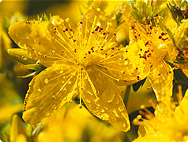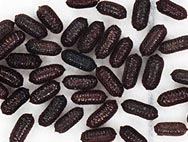
Hypericum perforatum L.
St. John's Wort

History
St. John's Wort, described in the works of Pliny and Dioscorides, was used in antiquity as a medication for somatic and emotional suffering. It was also a component of the Theriak (panacea), which Emperor Nero was given by his physician Andromachus as a universal antidote to poisonings. In the old Germanic solstice cultures, St. John's Wort played an important role. On the one hand, the shape and colour of its flowers referred to the sun, and on the other, it was regarded as a ’bringer of light’. With Christianity, the solstice and its plants were dedicated to John the Baptist since the plant begins flowering on Midsummer Day (June 24) and therefore contains the highest amount of active ingredients In folk legend, the plant's red juice symbolises the blood of John, the martyr. Authors of medieval herbal books also called the plant Corona regia, ’royal crown‘, because its flowers resemble a solar corona. St. John's Wort has long been used in the treatment of wounds and pain. In the middle ages and in the early modern period, it was also used as a psychotherapeutic and apotropaic (a substance warding off evil). It was used in exorcisms, as its name Fuga daemonum (Demon's flight) indicates. In 1525, Paracelsus wrote of St. John's Wort: ’Each physician should know that God has placed a great arcanum (secret) in the herb, just for the spirits and mad fantasies that drive people to despair. ’ The origin of the Greek name for the family, Hypericum, is unclear. One version has it that it is derived from ’hyper eikon‘ (exceeding any imagination) and refers to the plant's great healing power. However, it is more likely to refer to the Titan Hyperion (‘the superior’) whose union with Theia produced the sun god, Helios. Helios (also sometimes known as Hyperion) wears a crown of rays and is called ’the illustrious‘. The species name perforatum, meaning perforated, refers to the flowers and leaves, which look as if they have been perforated with needles.

Botanical characteristics
In spring, several hard, often reddish, hairless stalks grow 50 to 80 cm high from a widely-branched rootstock. The upper part of the stalk is branched and grows out widthways. A characteristic trait distinguishing St. John's Wort from other Hypericum species is the two longitudinal edges on the stalk. From it grow the stemless, opposing, oblong, entire leaves, which are covered with fine, black glandular points. The golden-yellow flowers stand at the tips of the upper twigs and form a broadly spread cyme. The five-tipped, asymmetric petals are also covered with excretory glands. Crushing the flowers produces a blood-red juice that dyes the fingers blue-violet. The numerous stamens are clustered in three bundles. H. perforatum has four subspecies distinguished by the breadth of their sepals. Adulteration and confusion with other, closely-related Hypericum species frequently takes place. They are recognisable by the stalks or by conducting thin-layer chromatography. St. John's Wort flowers from the end of June to September.

Habitat
St. John's Wort is native to and relatively widespread in the temperate climes of Europe, western Asia, and North Africa. It was also introduced to other temperate climes. It prefers sunny locations on dry, limy or primary rocky soils and is found on fallow land, the edges of meadows and forests, walls, and paths up to an altitude of 1500 metres.

Preparation
A.Vogel/Bioforce uses alcohol and oil extracts as well as homeopathic dilutions. They are prepared from the fresh shoot tips of St. John's Wort grown in controlled biological cultivation or collected in the wild. The plant is harvested shortly before full flowering. The use of the fresh herb ensures a relatively high hypericin content.
A.Vogel Blog – Natural and Healthy
Inspiration for a healthy life!
HERBAMARE SOUP-ER SOUPS!
DOWNLOAD YOUR FREE RECIPE BOOKLET!
8 healthy, hearty and delicious homemade soups.
Supporting a healthier happier you
“Nature is just about the best thing we’ve got!“
Alfred Vogel's guide to leading a healthy and happy life
Healthy & nutritious dinner ideas
Get new recipes in your inbox every month. Sign up now